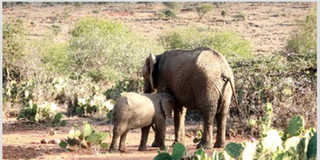Cactus: The thorny enemy spreading across Laikipia

A herd of elephants feeding on cactus plants at Loisaba conservancy in Laikipia County.
What you need to know:
- In Laikipia's wildlife conservancies, invasive plants are a growing problem that threatens the natural balance.
- The invasive cactus, for example, is interfering with animal navigation and encroaching on grazing areas, reducing pasture available for wildlife.
Despite its majestic presence in the wild, the elephant — the world’s largest mammal — is facing numerous threats, including poachers armed with poisoned arrows and bullets as well as retaliatory attacks from angry locals.
However, the gentle giant is also facing a unique and alarming threat from invasive plants such as cactus, which have made their way onto community lands as well as wildlife and livestock ranches in Laikipia County.
In Laikipia's wildlife conservancies, invasive plants are a growing problem that threatens the natural balance. These non-native plants, brought in by animals, humans, birds, and wind, compete with the native flora for vital resources such as moisture, sunlight, nutrients and space.
The invasive cactus, for example, is interfering with animal navigation and encroaching on grazing areas, reducing pasture available for wildlife. As one walks through the conservancies, it is easy to spot these invaders — some are short, others tall, some have yellow flowers and others are thorny. In addition to outcompeting native species, invasive plants also negatively impact water quality.
Elephants in Laikipia County are turning to cactus for food due to drought. However, the Opuntia Stricta variety is causing problems as an invasive species, blocking access to vital resources.
"Cactus is a major challenge in Laikipia and now we have a major complication because there is another cactus that is moving fast called Opuntia Engelmannii, and you can see their aggression through the pace at which they are moving," says Kimani Ndung'u, an ecological researcher.
While acknowledging that elephants have been feeding on cactus by kicking the plant to uproot it and accessing its roots, the researcher notes that elephants may have a unique ability to handle thorns that other animals do not possess. However, based on the observed effects of cactus consumption on other animals, it is still possible that elephants may be negatively affected as well.
"Because cactus has thorns, the animals’ eyes get pricked. Thorns and hairs enter the alimentary canal and cause wounds," he warns. According to ecological researchers, invasive plants are exacerbating competition for pasture among elephants and other domestic animals. This competition for food is expected to hasten the decline of elephant populations.
Fascinating facts about elephants from the World Wide Fund for Nature reveal that the animals consume up to 150 kilogrammes of food daily and are constantly eating. Additionally, baby elephants can join the herd in search of food and water within two days after birth. Elephants’ slow digestion leads to 66 per cent of their food being eliminated undigested, including the seeds of invasive plants like Opuntia Stricta.
This contributes to the spread of invasive plant species, which is increasing globally due to human and animal movement and climate change. African Forest Elephants and African Savanna Elephants are critically endangered.
To control the spread of Opuntia Stricta, a biological control agent called cochineal has been introduced by the Centre for Agriculture and Bioscience International. “The insects are more effective when they are multiplied, we normally do it in a makeshift greenhouse and disperse them across the landscape,” Ndung’u says. He explains the effects of cochineal.
"These are succulent plants and have a lot of sacs. Some get sucked while the granules at the top are getting weaker because they cannot get adequate water. They then fall off on the ground and germinate as their population increase.”
The cochineal insect has a unique diet consisting only of cactus plants, which it originally sourced from Central America — the natural habitat of the cactus. The successful biocontrol method, which utilises this insect, has been implemented in South Africa and now Kenya is following suit.
“Cochineal has been working by slowing seed production, but we still face challenges because it is not fast enough,” Ndung’u says.
Invasive plants have serious impacts such as Mathenge causing goats to lose their teeth and water hyacinth hindering fishing and disrupting lake ecology. Kenya is working on solutions, but challenges persist despite efforts like tree planting to mitigate drought effects.
The Ewaso Nyiro River, a vital water source for five million people, has suffered from decreased water levels due to human activities such as sand harvesting. This has caused challenges for adapting to and mitigating climate change. Dr Idriss Dokata and Dr Winnie Kiiru emphasise the severity of the issue and the crucial role the river plays in sustaining the region's biodiversity.
"We recorded elephant deaths here at Mpala and throughout the landscape. We found some carcasses with the ivory still intact, so we know they were not poached but died of starvation, which mostly affected older animals," she tells Climate Action, adding that overregulation is hindering research by scientists.
“We don’t have the luxury of monitoring anything for 20 years and that is why the tension now between regulatory environment and technology is one of the problems that researchers are having. Here is a conflict between science over-regulation, cost, licensing and security.”
Recent data from KWS indicates that the national elephant population exceeds 36,000. The Tsavo Ecosystem boasts the highest concentration of elephants, accounting for approximately 41 per cent of the total population. Meanwhile, Laikipia-Samburu ecosystem is home to 19 per cent, the Masai Mara Ecosystem to seven per cent, the Mount Kenya Ecosystem to 5.3 per cent and Mau ecosystem to 2.6 per cent of the elephant population.





